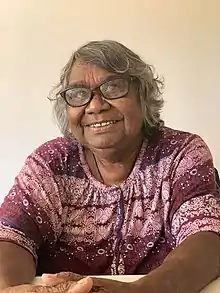
Kathleen Kemarre Wallace (born 1 July 1948), is an Eastern Arrernte artist, author, custodian and cultural leader from Ltyentye Apurte in the Northern Territory of Australia.[1]
Early life
Wallace was born near Ltyentye Apurte, a remote area of Central Australia. She is senior Eastern Arrernte speaker. Her family kept her away from stations and missions to prevent her removal under the Aboriginals Ordinance 1918 Act.[2] When she was 13, her family was forced to move to Santa Teresa Mission, now Ltyentye Apurte Community. This move was caused by severe drought and the interruption of traditional hunting and food gathering by encroaching station activities.[3]
Career
Wallace has lived on her homelands her whole life and she has always viewed it as her responsibility to ensure traditional knowledge is handed on; especially through art and storytelling.
In 1989 she was a founding member of Keringke Arts and, since then, has become one of their most successful artists and her work is represented in many national and international collections.[3]
Her artworks are very influenced by her Catholic faith and she says:
When I went to Santa Teresa, nuns taught me the Bible. When I came to Santa Teresa I couldn't speak English — I learned it there," she said. [Catholicism and my family's traditional beliefs] are similar — it wasn't hard for me. My grandfather's ancestors gave him a dream of three circles — grandfather, father and totem spirit — like the Holy Trinity.
— Kathleen Kemarre Wallace, [2]
Wallace has published two books Plants of the Santa Teresa region of Central Australia and Listen deeply: let these stories in.
In October 2019 the stained glass window that Wallace designed was installed at the Our Lady of Sacred Heart Catholic Church in Alice Springs which is celebrated for showing the blending of Catholic and Indigenous beliefs.[2] The title of the painting, which became the stained glass is Urtakwerte Atywerrenge Anthurre or, in English, Very Sacred Heart and it depicts the Virgin Mary and Jesus standing on a sandhill and different parts of the painting representing different aspects of her blended faith.[4] She also was a senior advisor on the Indigemoji app launched in 2019.[5] This app provides 90 emojis representing central Australia's Indigenous Arrernte culture and is Australia’s first set of Indigenous emojis.[6][7]
In addition to being an artist Wallace has worked as a teacher and served her community as an elected councillor for Ltyentye Apurte as well as being a member of the executive committee of Desart.[1]
Wallace and her husband Douglas had no children of their own but they have raised more than 30 children throughout their marriage; taking in children when they were neglected or their parents were drinking. This earned her the nickname "Mum".[1][3]
Selected works
- Wallace Kathleen Kemarre with Davis, Jane (1986), Plants of the Santa Teresa region of Central Australia
- Wallace Kathleen Kemarre with Lovell, Judy (2009), Listen deeply: let these stories in, IAD Press, ISBN 9781864650945
- Indigemoji (2019) App and website
Awards
- 2001 Finalist, National Aboriginal and Torres Strait Islander Art Award[1]
- 2010 Shortlist, Territory Read Awards for Listen deeply: let these stories in[8]
- 2020 Honoree, Public Service & Activism, Webby Award for Indigemoji[9]
- 2020 Honorary Mention, Digital Communities, Prix Ars Electronica for Indigemoji[10]
- 2020 Best Digital Product, First Nations Media Awards for Indigemoji[11]
References
- 1 2 3 4 "Kathleen Wallace". Central Art: Aboriginal Art Store. Archived from the original on 30 October 2022. Retrieved 7 November 2019.
- 1 2 3 Jonscher, Samantha (14 October 2019). "Aboriginal and Catholic faiths blended in stained-glass window of Alice Springs church". ABC News. Archived from the original on 14 September 2022. Retrieved 7 November 2019.
- 1 2 3 Wallace, Kathleen Kemarre, 1948- (2009). Listen deeply : let these stories in. Lovell, Judy. Alice Springs, N.T.: IAD Press. ISBN 9781864650945. OCLC 318534856.
{{cite book}}: CS1 maint: multiple names: authors list (link) CS1 maint: numeric names: authors list (link) - ↑ Finnane, Kieran (14 October 2019). "Arrernte Mary and Jesus watch over Alice's Catholics". Alice Springs News. Archived from the original on 18 November 2022. Retrieved 7 November 2019.
- ↑ "anwerne-akerte // team". Indigemoji. Archived from the original on 25 October 2022. Retrieved 19 January 2020.
- ↑ Quinn-Bates, Jennetta (28 November 2019). "Indigemoji app provides 90 emojis representing central Australia's Indigenous Arrernte culture". ABC News. Archived from the original on 27 May 2022. Retrieved 14 December 2020.
- ↑ "Indigemoji". Indigemoji. Archived from the original on 25 October 2022. Retrieved 14 December 2020.
- ↑ "Territory Read short list..." (PDF). Write Turn: 5. February–March 2010. Archived (PDF) from the original on 29 October 2022.
- ↑ "Indigemoji". The Webby Awards. Archived from the original on 23 November 2022. Retrieved 18 March 2021.
- ↑ "Digital Communities 2020". Prix Ars Electronica. Retrieved 18 March 2021.
- ↑ "First Nations Media Australia Award winners". Radio Info. 22 December 2020. Archived from the original on 22 December 2020. Retrieved 18 March 2021.